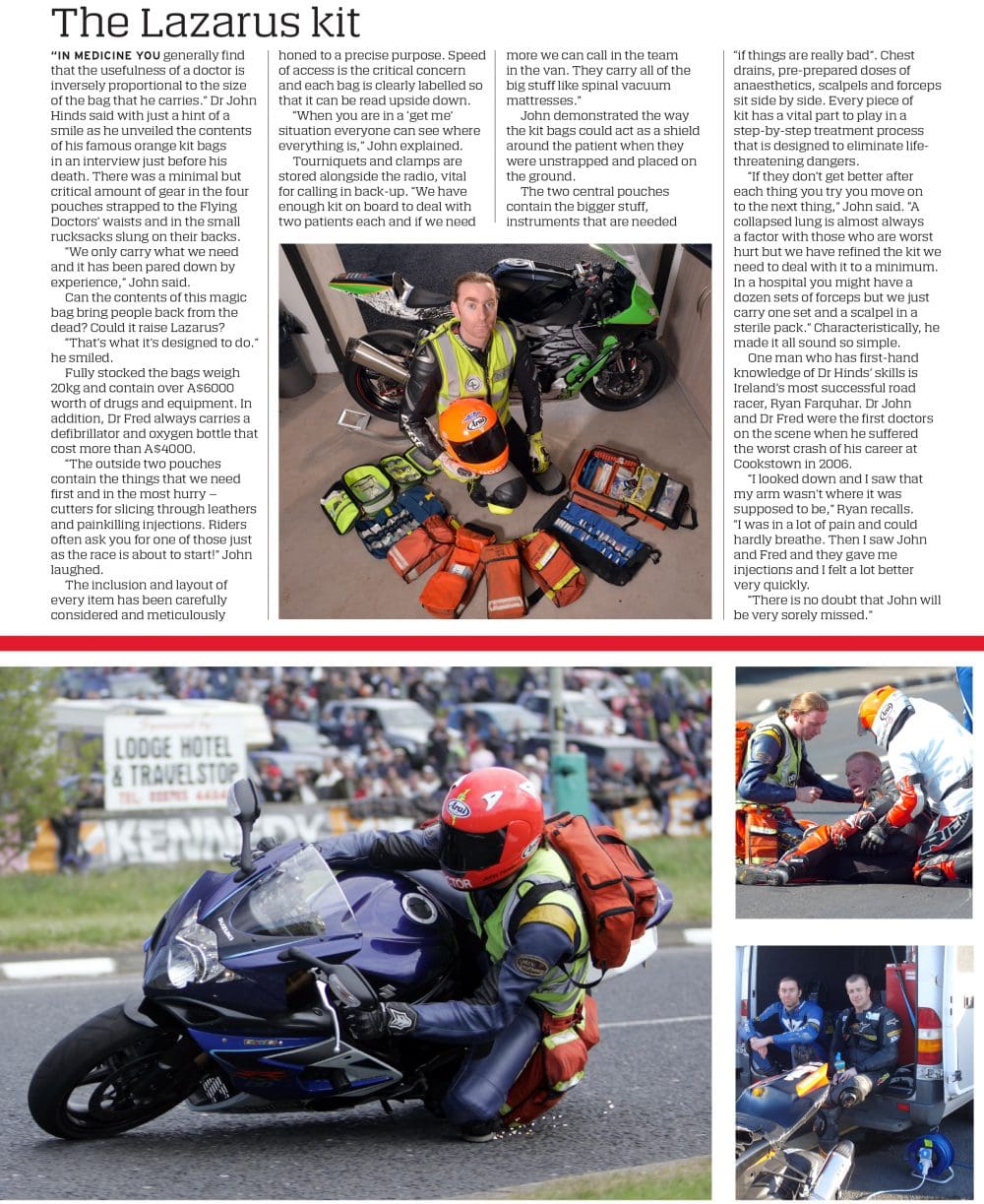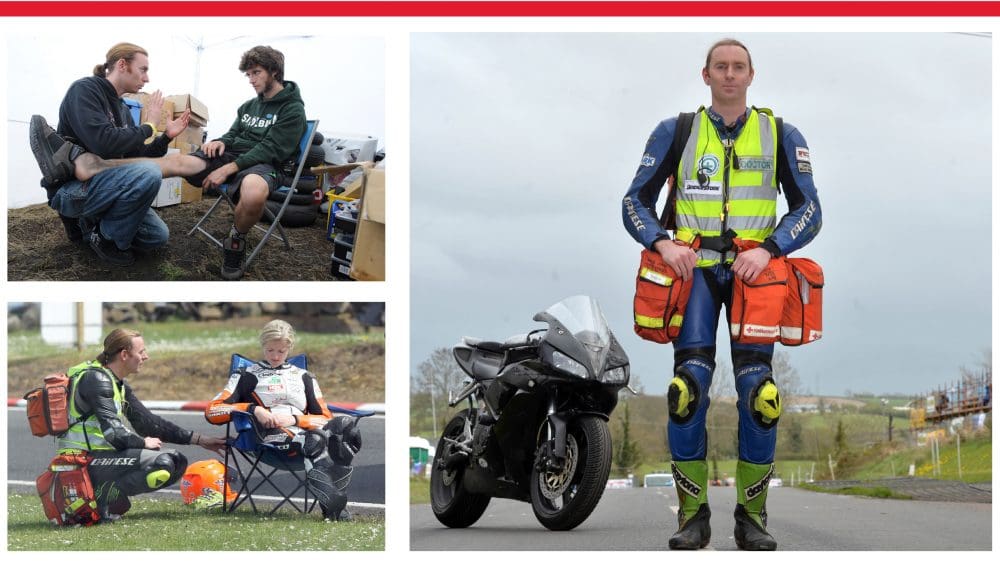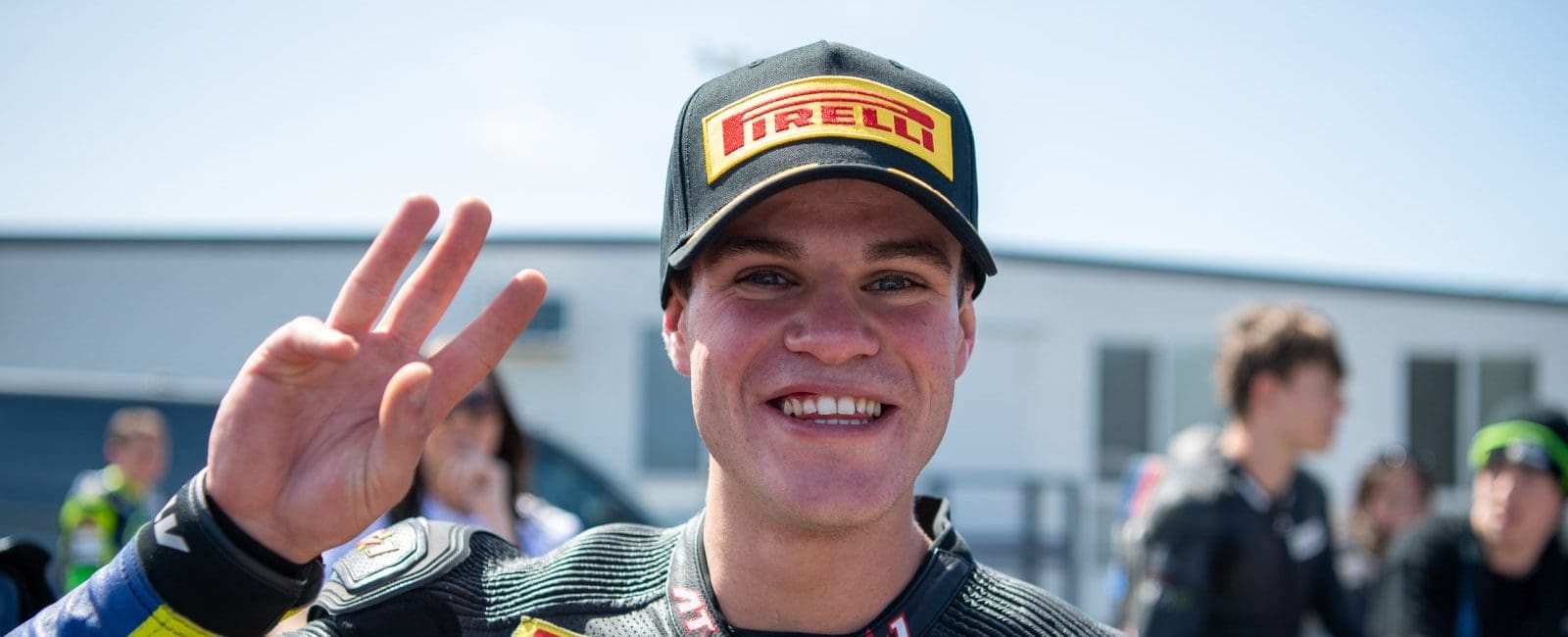Alongside his colleague Fred MacSorley, John Hinds became famous as one of the Flying Doctors. Mounted on motorcycles and carrying bright orange packs stuffed with medical equipment, the pair provided the fastest medical response in world motorsport, saving countless lives at Irish bike races over the past decade. But tragically, while 35-year-old John was tracking a group
of riders during a practice session at the Skerries 100 on 4 July 2015 he inexplicably crashed his BMW S1000RR and sustained fatal injuries.
The death of the man who had watched over everyone else in the high-risk business of racing on closed public roads stunned the bike racing paddock and left his family and friends devastated.
“John always believed there was something that he could do to save lives.” his partner Janet says as she sits in the couple’s living room surrounded by pictures of herself as half of a happy couple that no longer exists. “He realised that using the bike he could get to the scene of a crash much faster. Those first few seconds are vital in not only ensuring someone survives but also in making sure they survive intact.
“Of course he got to indulge his passion for riding bikes too!” Janet adds. “John adored being on the bike and he wouldn’t have been able to do the work he did if he hadn’t.”
Unusually in Ireland, no one in John’s family was interested in motorbikes. But as they lived close to Kirkistown, one of Northern Ireland’s short circuit tracks, he became curious about what was going on there.

After watching his first track races at about 14 or 15, John went to the Ulster Grand Prix at Dundrod and was immediately smitten by the spectacle of road racing. At the age of 17 he acquired his first roadbike, a Suzuki RG125. When he later enrolled in medical school, he had the opportunity to dovetail his twin loves of medicine and biking. John explained the route he took in an interview he gave me shortly before his death.
“It isn’t until your third year of medical training that you actually meet any patients and it is usually in a clinic or GP’s surgery,” he said. “My first patients were road racers.”
John signed up as a member of the Motorcycle Union of Ireland Medical team. Using a van and medical cars loaded with resuscitation equipment, the squad of doctors and paramedics – all full-time medical professionals – provide their services at races as unpaid volunteers.
Initially, John observed the squad in action before being allowed to go hands-on himself.
“You have to familiarise yourself with how racing works, how the sport and its environment operates, or you are of no use to anyone,” he explained. “You need to know things like the way a two-stroke goes silent when you shut the throttle, or you could be running out in front of bikes that are still racing. You learn those things and how to fit into the team during your two-year apprenticeship.” The apprenticeship also involved honing his riding skills.
“Fred and John loved riding their bikes and they went to Jerez and Almeria in Spain during the winter with (former North West and British championship race winner) Woolsey Coulter for coaching sessions,” Janet recalls. “I even bought him trackdays at Mallory Park as a birthday present. It was really important to him that I enjoyed the bike too and I rode pillion with him, getting my knee down a couple of times!”

Fun as his biking was, it was also a crucial part of John’s race-day job as neither Fred nor him could risk getting caught by the likes of Michael Dunlop or Guy Martin as they followed on the opening lap.
“His riding skills were extremely important to him and John would never put anyone else at risk,” Janet explains. “He had to be sure he was fast enough and his garage was like an operating theatre as he meticulously checked out his bike before every meeting. He saw all of that as part of his duty of care.”
Wanting to know what it was like “to be on the inside”, John even tried racing himself on a GSX- R1000 Suzuki at Aberdare Park and on the Irish short circuits.
“How can you give advice if you don’t know what you are talking about?” he said. Although he laughed at the suggestion that his insight into competition helped improve his bedside manner, there was no doubt that it increased the respect and affection in which he was held by the racers.
Working with fellow physicians in the MCUI Medical team also provided John with inspiration.
“I was watching experts at work in the team,” John told me. “I saw them descend on someone who had crashed and was in the active stages of the dying process and they turned that around. That is a very seductive thing and I aspired to be like those people.”
His medical skills were long in their gestation: five years of medical school, a year as a pre- registrar and seven more years of combined training and practice eventually provided him with a double consultancy as an anaesthetist and intensivist in a Co Armagh hospital.
As is often the case among people who work in extreme circumstances, Dr John had a wit that was Saharan in its aridity, with a propensity for black humour to match.
“I’m a bit of a jack of all trades in the medical world,” was how he described his doctor’s skillset. “It means that I can fix stuff as well as knock people out – and of course these skills are very transferable to dealing with crashes.”

Although John was to eventually become the leading light in the MCUI Medical team, he never sought to lay claim to any of the team’s numerous “saves”. Self-effacing and quietly spoken, he prefered to use “we” rather than “I” in his conversation, emphasising the importance of the squad’s tightly co-ordinated approach. And although highly respected by fellow professionals and the racing community alike, John shied away in life from the type of exposure that has surrounded him following his death. He preferred the company of close friends, socialising with some of the paddock’s lesser known names.
“John was a real race fan,” Janet says. “We booked our whole holidays around the racing calendar and he would record and watch every MotoGP and TT race. Because he was out on track when he was working he was never sure who was winning and I had to be able to tell him who finished where when he got back in. He enjoyed meeting all of the top riders and chatting to them. Some, like Guy Martin, even stayed at our house, but John didn’t do celebrity and he would be shaking his head about all the attention that he has had since the crash.”
In 2010, in a crash at Skerries, John lost one of his closest friends, Myles Byrne. The death hit him very hard.
“I rode back to the paddock and cried my eyes out,” he told me after his best efforts had failed to save his friend.
“John was very close to Myles and his death had a huge effect on him,” Janet recalls. “Typically though, he dug his heels in and resolved to develop his resuscitation techniques even though it wouldn’t have helped Myles. He was driven on to improve by his loss.”
John’s hands on approach at the very pointiest end of medical care exposed him to some of the toughest trauma challenges imaginable. Calling on the experience he gained, he began to deliver lectures all over the world to medical conferences, gaining international recognition for pioneering techniques that were developed through the treatment of injured Irish road racers.
“I have always been drawn to the high acuity stuff because dealing with the sickest patients pushes you to really think on your feet,” he told me last year. “That is what I got into medicine for and it provided me with the model of what a doctor should be.”
Irish bike racing is still reeling from Dr John’s loss but his mentor, Dr Fred, has vowed to continue.
“Nobody did it as well as he did,” Dr MacSorley says. “But I’ll have to find someone and train them up, and continue to do my best for patients at the side of the road.”
John’s work in areas such as the previously unrecognised Brain Apnoea Syndrome brought him professional plaudits amongst his medical peers – and new opportunities. Job offers came from Dubai, Sydney, and even the military.
“A few years ago the British Army made a determined effort to recruit John to work for them with injured soldiers on the front line in Afghanistan,” Janet recounts. “He was very tempted by that because the military had all the very latest technology and equipment at their disposal but in the end he decided to stay and work in Northern Ireland.”

One cause that John felt passionately about was the need for a full air ambulance emergency medicine service for Northern Ireland, and he had begun a determined campaign for this before his untimely death.
“John was very, very opposed to needless deaths, and statistics show that perhaps as many as 600 people who have been involved in accidents in Northern Ireland since 2003 would still be alive today if we had this service,” Janet explains. “An air ambulance service has been seen as a luxury rather than a necessity but John saw it as a fundamental need and had began to push for its provision.”
Janet and the rest of those now involved in the HEMSNI air ambulance campaign are determined to see the emergency service introduced as part of John’s legacy.
“John wanted the very best for the place where he loved living.” Janet says. “ He went to Australia in 2014 and saw the HEMS system in operation there and came back frustrated that we didn’t
have something like that at home. After that he started the campaign, and if there is going to be anything good to come out of John’s death it will be a HEMSNI service.”

PICTURE BY STEPHEN DAVISON
WORDS AND PHOTOGRAPHY STEVEN DAVISON











